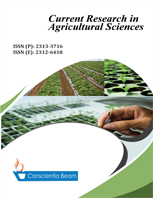Utilization of Fish and Mango Wastes on Biological Silage Production
DOI:
https://doi.org/10.18488/journal.68.2018.51.6.14Abstract
The aim of this study was to demonstrate the utilization of mango and fish wastes in biological silage production. Six treatments containing different levels of fish and mango wastes, sugar cane molasses and corn stover were inoculated with 4 % of Lactobacillus sp. B2 strain and incubated 15 days at 30 °C. The pH values of silages varied from 4.39 to 4.70 and the lactic acid content between 2.96 to 4.42 %. Silages showed the best acidifying at 7 day of fermentation; also they further increased the lactic acid bacteria counts and decreased the coliforms bacteria. Crude protein, ethereal extract and minerals values were higher in treatments with the upper level of fish wastes. The silage with the higher corn stover showed the upper crude fiber value and the lower in vitro dry matter digestibility. Contrary, the high inclusion level of fish wastes resulted in the highest dry matter digestibility. In conclusion, the combination of fish and mango wastes is a good alternative to produce biological fish silage as an ingredient for ruminants feed. The process of production is simple and environmental friendly.

